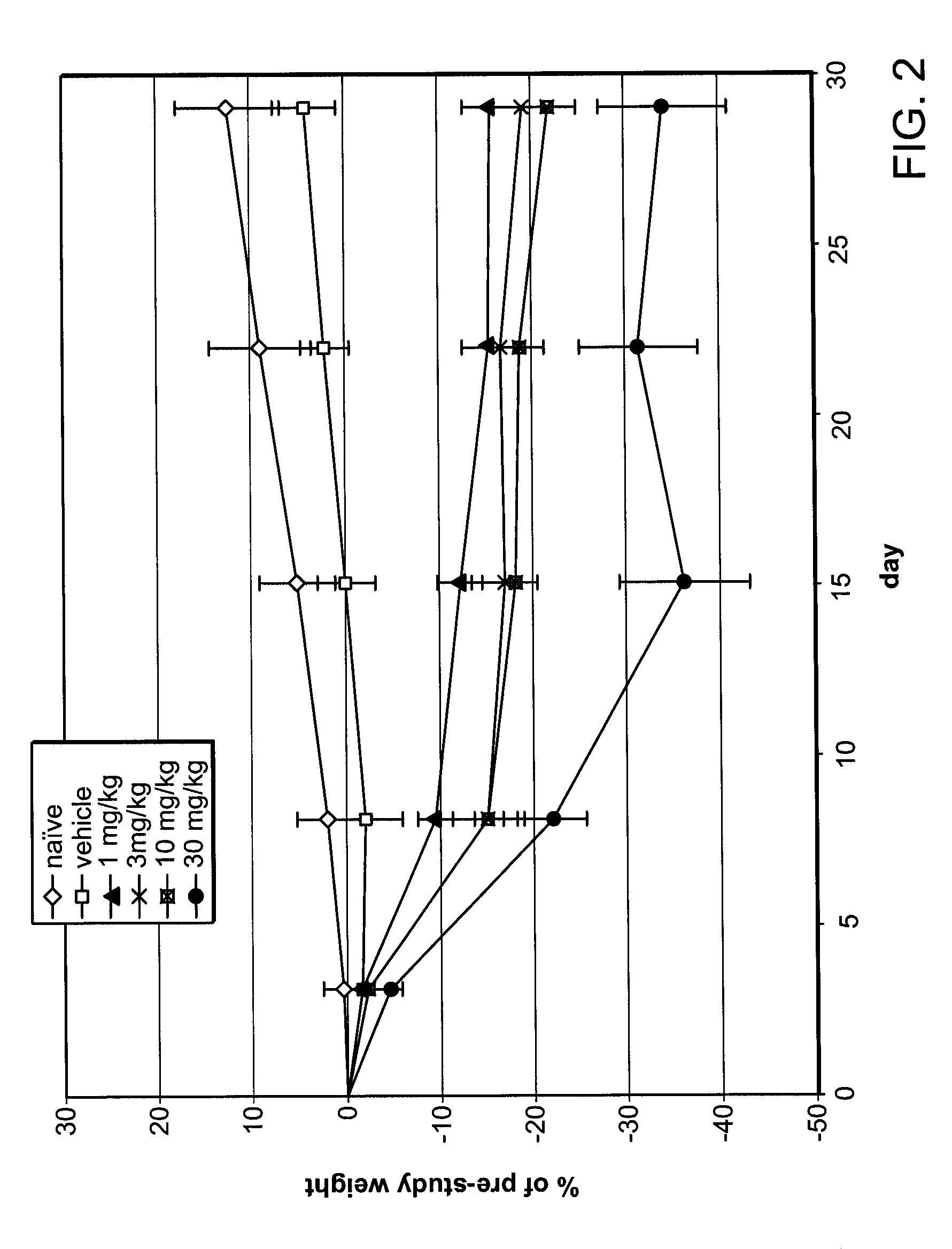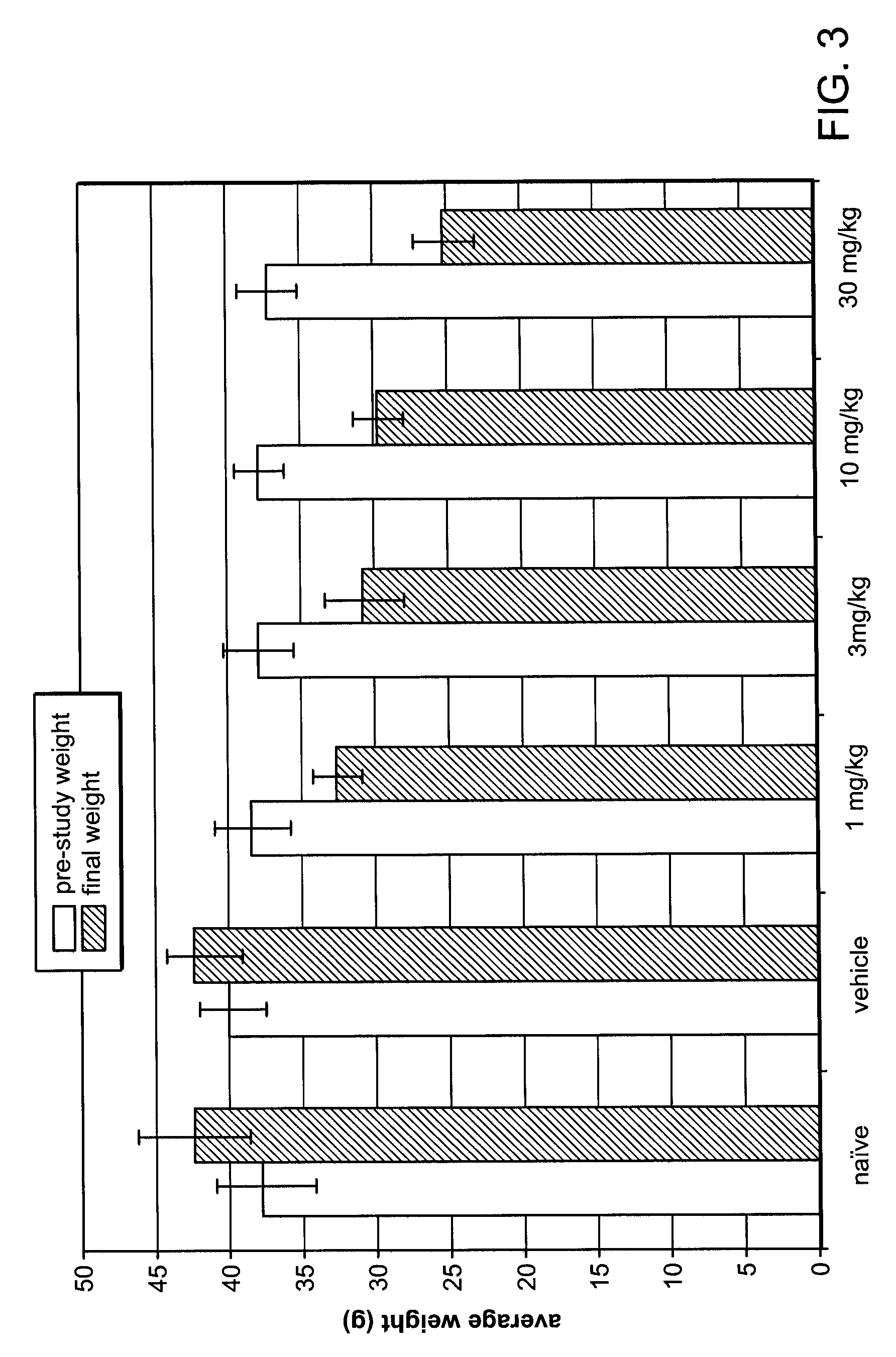Methods of treating an overweight or obese subject
a technology of overweight or obese subjects and formulations, applied in the direction of biocide, drug composition, metabolic disorder, etc., can solve the problems of no curative treatment for being overweight or obese, erratic blood levels of fumagillin, and rapid metabolic degradation of fumagillin
- Summary
- Abstract
- Description
- Claims
- Application Information
AI Technical Summary
Benefits of technology
Problems solved by technology
Method used
Image
Examples
example 1
Fumagillin binding to MetAP-2 in Adipose Tissue of Obese Mice
[0166]Fumagillin is an anti-angiogenic compound that binds to the MetAP-2 protein. A study was designed to determine whether fumagillin binds MetAP-2 in adipose tissue. The results show that fumagillin binds MetAP-2 in adipose tissue.
[0167]Diet-induced obese mice were orally (p.o.) administered fumagillin (3 mg / kg or 10 mg / kg; Medivet), subcutaneously administered (s.c.) TNP-470 (1 mg / kg, 3 mg / kg, 10 mg / kg, or 30 mg / kg; synthesized by standard semi-synthetic processes as described in European Patent EP 0 357 061), or administered a solution of 10% dimethyl sulfoxide (DMSO; control; Sigma-Aldrich). Mice were sacrificed and adipose tissue samples were obtained.
[0168]An ELISA assay of MetAP-2 binding was conducted with tissue lysates prepared from the adipose tissue samples. The MetAP-2 ELISA is a quantitative assay to determine the amount of free MetAP-2 in tissue or cell lysates, i.e., MetAP-2 not covalently bound to fumagi...
example 2
Orally Administered Fumagillin Causes Weight Loss in Diet-Induced Obese Mice
[0171]Based on data shown in Example 1, a weight loss study was conducted in obese mice. The mice in this study were not genetically obese, but prior to and during the study, obesity was induced by a high-fat diet. Twelve week-old C57BL / 6NTac mice, maintained on a 60% fat diet prior to and during the study, were separated into six groups, eight animals per group. Average body weight of the mice was 38 g at the start of the study.
[0172]Fumagillin was administered to four of the diet-induced obese mice groups by oral gavage as a solution in 10% DMSO, at doses of 1 mg / kg / day, 3 mg / kg / day, 10 mg / kg / day and 30 mg / kg / day respectively, for 28 days. A fifth group received 10% DMSO vehicle-only (control) by oral gavage, and the sixth group received neither vehicle nor fumagillin (naïve). Body weight was measured on day 0 (pre-study) and subsequently on day 3, day 8, day 15, day 22, and day 29 of the study. Daily food...
example 3
Fumagillin Causes Weight Loss in Diet-Induced Obese Mice at Very Low Doses
[0179]In view of the surprising data showing a weight loss response to fumagillin at a dose as low as 1 mg / kg / day (See Example 2), a further study was conducted using even lower doses, i.e., 0.1 mg / kg / day and 0.3 mg / kg / day.
[0180]Mice were divided into two groups, a diet-induced obese group and a lean group. For the diet-induced obese group, fifteen week-old C57BL / 6NTac mice, maintained prior to and during the study on a diet containing 60% fat on a kilocalorie basis, were further separated into six groups, eight animals per group. Average body weight of these diet-induced obese mice was 38 g at the start of the study. For the lean group, fifteen week-old C57BLI6NTac mice, maintained on a diet containing 4.3% by weight fat prior to and during the study, were further separated into two groups, eight animals per group. Average body weight of these lean mice was 28 g at the start of the study.
[0181]Fumagillin was ...
PUM
| Property | Measurement | Unit |
|---|---|---|
| body weight | aaaaa | aaaaa |
| time | aaaaa | aaaaa |
| time | aaaaa | aaaaa |
Abstract
Description
Claims
Application Information
 Login to View More
Login to View More - R&D
- Intellectual Property
- Life Sciences
- Materials
- Tech Scout
- Unparalleled Data Quality
- Higher Quality Content
- 60% Fewer Hallucinations
Browse by: Latest US Patents, China's latest patents, Technical Efficacy Thesaurus, Application Domain, Technology Topic, Popular Technical Reports.
© 2025 PatSnap. All rights reserved.Legal|Privacy policy|Modern Slavery Act Transparency Statement|Sitemap|About US| Contact US: help@patsnap.com



